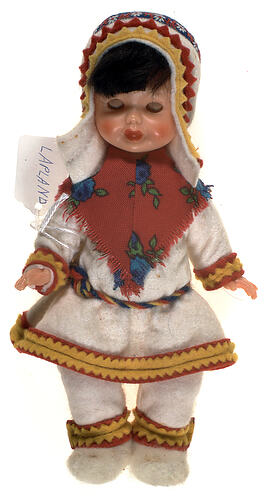Summary
National doll produced to represent a Sami woman, it was given to Monica Gates, circa 1970s-1980s. The Sami peoples (previously referred to as Lapps) are the indigenous inhabitants of Northern Norway, Sweden, Finland and the Kola Peninsula of Russia. They traditionally lived by fishing, hunting and from the 17th Century reindeer herding, with lifestyle depending on the area they inhabited, coastal, interior or mountains.
Sami clothing for both men and women consists of a belted coat, pants (for men), leggings (for women) and headdress. Moccasins or boots and mittens are generally made from reindeer skin. The material used for making the coat varied according season and usage, in winter a moudda (double coat of reindeer skin) was generally worn, while winter festival coats were often made from the more delicate reindeer calfskin. Summer coats were constructed from homespun cloth (gakti) or chamois (svaltja). Gakti may be coloured blue, black, white or occasionally green. They have bands of ornamentation in red, yellow, green or blue. The colour and ornamentation of gakti and the style of headdress worn signify regional, gender, age and usage differences. White gakti are often used for festive occasions.
This style of cap is similar to the jorbor worn by Sami women in Karesuando, northern Sweden, although they are traditionally trimmed with lace. Many Sami women today wear caps of this style regardless of which region they come from, although unlike the jorbor the decoration is generally simple with ornamentation around the ear flaps and crown.
The Gates collection contains 170 national dolls from 74 different countries and some correspondence relating to the acquisition of several of the dolls. The costumes of the dolls represent national costumes from the 19th Century to the 1990s. Monica Gates collected or was given these dolls between 1957 and 1990.
These dolls were purchased as souvenirs of particular countries and like many mass produced souvenirs they are often not accurate representations of a particular country or region, and may actually better reflect neighbouring counties or regions. This occurs because costumes are often stylised and simplified resulting dolls wearing generic costume elements which are common to many countries/regions. Often the fabrics and decorations used are selected to make the dolls cheap and easy to manufacture and aesthetically pleasing. This can result in the fabrics, colours and decorations of the doll's clothing having little or no reflection of the costume associated with a particular country or region they are meant to be representative of.
Physical Description
Doll, plastic, with eyes that shut when laying down. It is dressed in white felt trousers and shoes, with a matching tunic and bonnet. There is red and yellow trim around the cuffs and hems of these garments. There is a red, yellow and blue cord tie around the waist of the doll and it is wearing a red scarf with a blue and green floral pattern around its neck. There is blue braid with red and white flowers around the back of the bonnet.
More Information
-
Collecting Areas
-
Acquisition Information
Purchase
-
Place Made
Norway, circa 1970s-1980s
As the doll is dressed to represent a Sami person it could also have been made in Sweden, Finland or north-west Russia which also have Sami populations -
User
-
Other Association (See Comments)
Sapmi
Doll is intended to represent a Sami woman. -
Inscriptions
"LAPLAND" (-written on attached paper tag)
-
Classification
-
Category
-
Discipline
-
Type of item
-
overall dimensions
11 cm (Length), 6.5 cm (Width), 20 cm (Height)
-
References
Tom G. Svensson (1992). 'Clothing in the Arctic: A Means of Protection, a Statement of Identity', Arctic, Vol 45, No 1 (March), pp. 62-73
-
Keywords
Children's Play, Clothing, Cultural Awareness, Cultural Beliefs, Dolls, Indigenous Cultures, Indigenous Peoples, National Costumes, National Identity, Souvenirs
